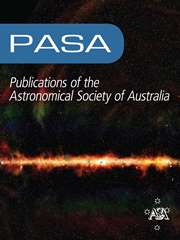No CrossRef data available.
Article contents
Brown dwarf number density in the JWST COSMOS-Web field
Published online by Cambridge University Press: 07 April 2025
Abstract
Brown dwarfs are failed stars with very low mass (13 to 75 Jupiter mass), and an effective temperature lower than 2500 K. Their mass range is between Jupiter and red dwarfs. Thus, they play a key role in understanding the gap in the mass function between stars and planets. However, due to their faint nature, previous searches are inevitably limited to the solar neighbourhood (20 pc). To improve our knowledge of the low mass part of the initial stellar mass function and the star formation history of the MilkyWay, it is crucial to find more distant brown dwarfs. Using JamesWebb Space Telescope (JWST) COSMOS-Web data, this study seeks to enhance our comprehension of the physical characteristics of brown dwarfs situated at a distance of kpc scale. The exceptional sensitivity of the JWST enables the detection of brown dwarfs that are up to 100 times more distant than those discovered in the earlier all-sky infrared surveys. The large area coverage of the JWST COSMOS-Web survey allows us to find more distant brown dwarfs than earlier JWST studies with smaller area coverages. To capture prominent water absorption features around 2.7 μm, we apply two colour criteria, F115W – F277W + 1 < F277W – F444W and F277W – F444W > 0.9. We then select point sources by CLASS_STAR, FLUX_RADIUS, and SPREAD_MODEL criteria. Faint sources are visually checked to exclude possibly extended sources. We conduct SED fitting and MCMC simulations to determine their physical properties and associated uncertainties. Our search reveals 25 T-dwarf candidates and 2 Y-dwarf candidates, more than any previous JWST brown dwarf searches. They are located from 0.3 kpc to 4 kpc away from the Earth. The spatial number density of 900-1050 K dwarf is (2.0 ± 0.9) × 10–6 pc–3, 1050–1200 K dwarf is (1.2 ± 0.7) × 10–6 pc–3, and 1200–1350 K dwarf is (4.4 ± 1.3) × 10–6 pc–3. The cumulative number count of our brown dwarf candidates is consistent with the prediction from a standard double exponential model. Three of our brown dwarf candidates were detected by HST, with transverse velocities 12 ± 5 km s–1, 12 ± 4 km s–1, and 17 ± 6 km s–1. Along with earlier studies, the JWST has opened a new window of brown dwarf research in the MilkyWay thick disk and halo.
- Type
- Research Article
- Information
- Creative Commons
- This is an Open Access article, distributed under the terms of the Creative Commons Attribution licence (https://creativecommons.org/licenses/by/4.0/), which permits unrestricted re-use, distribution and reproduction, provided the original article is properly cited.
- Copyright
- © The Author(s), 2025. Published by Cambridge University Press on behalf of Astronomical Society of Australia


